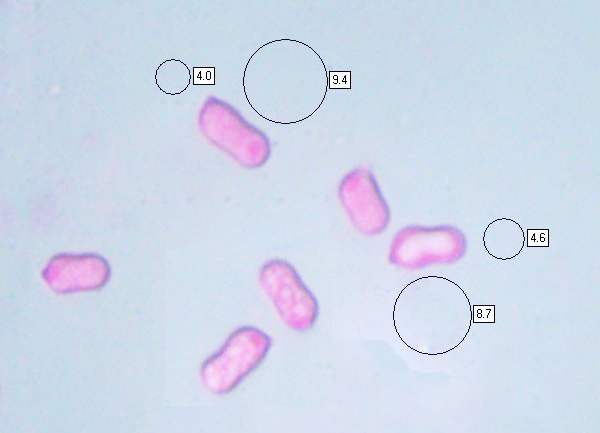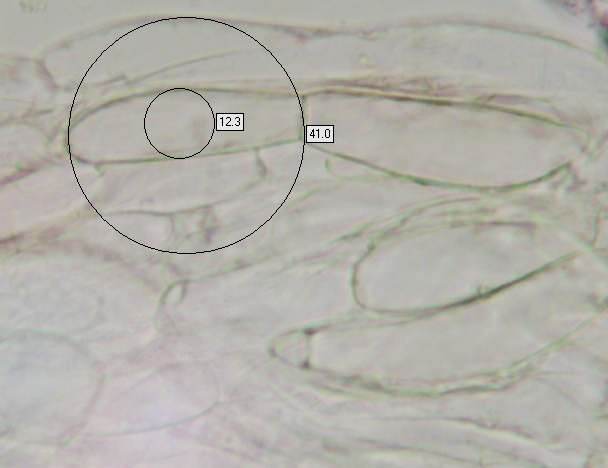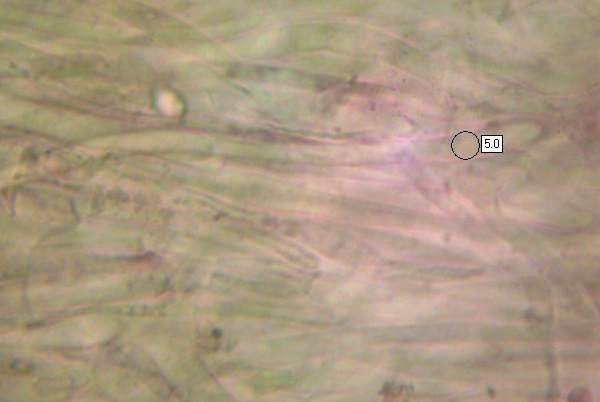Hygrocybe quieta (Kühner) Singer - Oily Waxcap
Phylum: Basidiomycota - Class: Agaricomycetes - Order: Agaricales - Family: Hygrophoraceae
Distribution - Taxonomic History - Etymology - Identification - Culinary Notes - Reference Sources
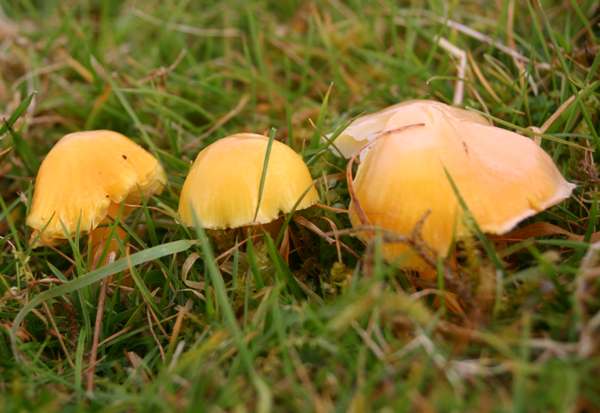
This orange-yellow waxcap occurs mainly in grassland but is also found occasionally in woodland glades. It seems to show no particular affinity for any soil type, as the Oily Waxcap is quite common on both acidic and basic soils.
An oil-like odour is emitted from the crushed gills of this waxcap, otherwise it would be very difficult to identify without resorting to microscopy.
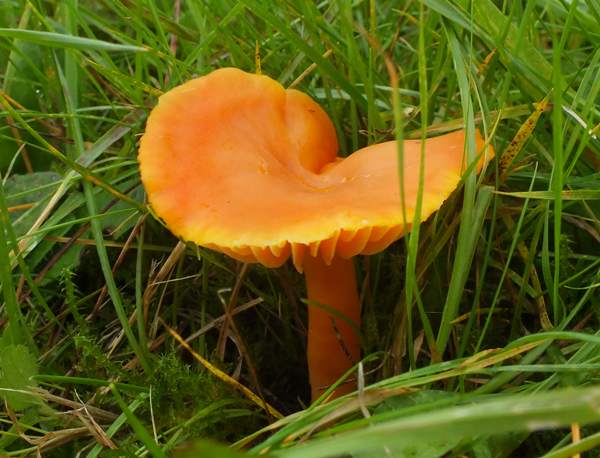
Distribution
An infrequent find in Britain and Ireland but often plentiful in those location in which it occurs, the Oily Waxcap is relatively common and widespread throughout England, Wales and Scotland. In Ireland this waxcap is also widespread and fairly abundant. Hygrocybe quieta is also widely distributed throughout northern and central mainland Europe. This waxcap sometimes occurs in woodland settings, as pictured left.
Taxonomic history
When French mycologist Robert Kühner (1903 - 1996) described this fairly common grassland mushroom in 1947 he gave it the name Hygrophorus quietus. Four years later the German-born mycologist Rolf Singer (1906 - 1994) transferred the Oily Waxcap to the genus Hygrocybe, since when its accepted scientific name has been Hygrocybe quieta.
Etymology
The genus Hygrocybe is so named because fungi in this group are always very moist. Hygrocybe means 'watery head'.
The Latin epithet quieta is probably a reference to the inconspicuous (quiet, unobtrusive) colours of this visually nondescript waxcap. (Some people refer to this species as the Tranquil Waxcap.) The same specific epithet is applied to one of the rather dull, brown milkcaps, and by coincidence when their gills are cut or crushed the Oakbug Milkcap Lactarius quietus and the Oily Waxcaps Hygrocybe quieta even smell somewhat similar - they both give off an oily-fruity odour (or, as some authorities suggest, of squashed shield bugs. (Experts on the smell of squashed bugs are welcome to contact us on this matter.) We could of course look for a more interesting explanation: the specific epithet quieta is variously translated as quiet in the sense of 'settled', in other words not moving. Other than the Rolling Puffball Bovista plumbea I can't think of a fungus for which unmoving would be an inappropriate adjective; however, 'Aqua profunda est quieta' translates to 'Still waters run deep' - troubled waters can be calmed (made quiet) by pouring oil on them. There's limited potential here, I fear, as relying on the Oily Waxcap for the necessary unction would definitely restrict us to calming only very small seas.
Identification guide
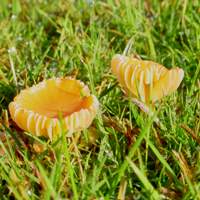 |
CapDryer than most waxcaps, the cap is yellow or yellow-orange and expands to typically 4 to 6cm in diameter. The caps of the Oily Waxcap are always convex rather than conical; in dry weather they tend to flatten and often become concave (with upturned edges). |
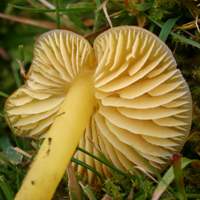 |
GillsThe broad gills are widely spaced, paler than the cap, and deeply notched; they are broadly attached to the stipe. StemColour the same as the cap or a little paler, with no ring, the level diameter stipe is 5 to 10mm in diameter and ranges between 2 and 7cm tall. |
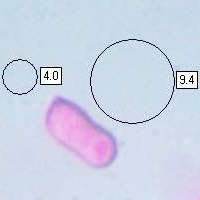 |
SporesEllipsoidal to oblong with a central constriction, smooth, 7.5-9.0 x 3.5-5μm; inamyloid.
Spore printWhite. |
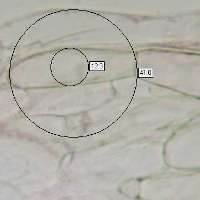 |
Gill trama
|
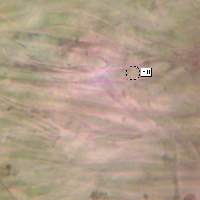 |
PileipellisA cutis with a few erect terminal hyphae, mostly 4 to 8μm in diameter.
|
Odour/taste |
This waxcap has a slight soapy or oily odour said (by those who go around sniffing such things) to be reminiscent of bed bugs or shield bugs! If you squash a piece of gill material between your fingers the smell is more readily detectable. |
Habitat & Ecological role |
Close-cropped or mown acid grassland where artificial fertilisers are not spread. Waxcaps have long been considered to be saprobic on the dead roots of grasses and other grassland plants, but it is now considered likely that there is some kind of mutual relationship between waxcaps and mosses. |
Season |
August to December in Britain and Ireland. |
Similar species |
Gliophorus laetus is smaller, usually darker, and has decurrent gills. Hygrocybe intermedia is very similar but usually more orange and has a fibrous, non-greasy cap that does not smell soapy when squashed. |
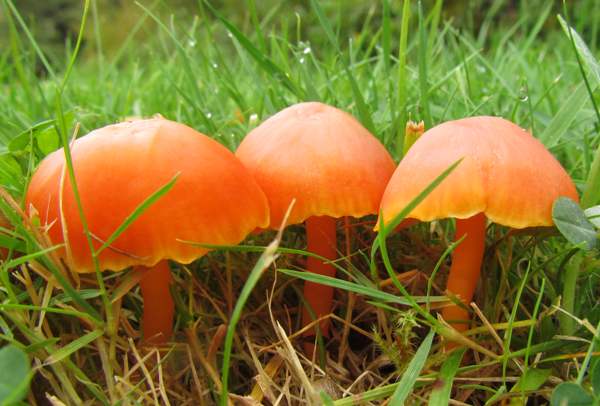
Culinary Notes
Although not known as a seriously toxic toadstool, the Oily Waxcap is not generally considered edible because the caps are so insubstantial (and they do not smell very appetising). In any case, waxcaps of any sort are far from common and picking them cannot improve the situation.
Reference Sources
Fascinated by Fungi, 2nd Edition, Pat O'Reilly 2016, reprinted by Coch-y-bonddu Books in 2022.
Fungi of Northern Europe, Volume 1 - The Genus Hygrocybe, David Boertmann, 2010.
Dictionary of the Fungi; Paul M. Kirk, Paul F. Cannon, David W. Minter and J. A. Stalpers; CABI, 2008
Taxonomic history and synonym information on these pages is drawn from many sources but in particular from the British Mycological Society's GB Checklist of Fungi.
Fascinated by Fungi. Back by popular demand, Pat O'Reilly's best-selling 450-page hardback book is available now. The latest second edition was republished with a sparkling new cover design in September 2022 by Coch-y-Bonddu Books. Full details and copies are available from the publisher's online bookshop...

